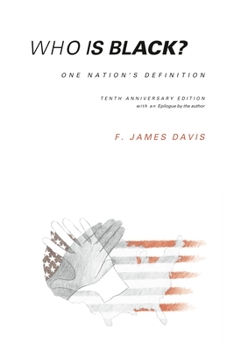Who is Black?: One Nation's Definition
Select Format
Select Condition 
Book Overview
How does a person get defined as a black, both socially and legally, in the United States? This is the first comprehensive study of the so-called "one-drop rule" that defines as black any person having at least one black ancestor. Who is Black? provides both a history and an analysis of miscegenation in the United States, showing how a black person is defined, how this definition emerged from the slave South to become the nation's definition with the backing of state and federal courts, how the definition works in everyday life, and what the consequences of the definition are. According to the one-drop rule, anyone with at least one African black ancestor is black, even if the individual appears to be white. The rule originated during the era of slavery in the South and has come to be taken for granted, strongly supported by blacks and whites alike. No other nation defines a black person in this fashion. Davis provides a comparison of the one-drop rule with six other ways of defining the status of racially mixed persons in societies around the world, from Latin America to South Africa. No other racially (biologically) distinctive minority group in the United States is subject to a one-drop rule. The concept of "passing as white," which reflects the one-drop rule, applies only to persons with some African black ancestry. As a consequence, persons with even very small fractions of black ancestry cannot be assimilated in the United States as people with one-fourth or less American Indian or East Asian ancestry can be. Davis discusses the dilemmas of racial identity experienced by well-known public figures, including Lena Home, Adam Clayton Powell, and Walter White of the NAACP. Conflicts over color in the black community are also discussed, along with such further problems as collective anxieties, the racial identity of transracially adopted children, different modes of adjustment to ambiguities about racial identity, and personal traumas. Finally, the question of potential changes in the one-drop rule is considered in order to demonstrate how entrenched the rule now is in the black community as well as the white, and why.
Format:Paperback
Language:English
ISBN:0271007494
ISBN13:9780271007496
Release Date:June 1991
Publisher:Penn State University Press
Length:216 Pages
Weight:0.80 lbs.
Dimensions:0.6" x 6.0" x 9.0"
Customer Reviews
3 ratings
Fascinating exploration of the "one-drop rule".
Published by Thriftbooks.com User , 20 years ago
This is one of the best books I've ever read. Americans of all ethnic groups should read this, because it answers a lot of questions. To me it seems absurd to believe that human beings can be divided into discrete biological "races," and this book provides plenty of evidence for that view.
What makes a Lightskinned Person black??
Published by Thriftbooks.com User , 24 years ago
This sheds Light on that Question.It isn't as biological as it is so social.I've heard the Arguement that lightskin Black aren't Black at all.Biologically that's true,however as I look around the city where I live and see many lightskinned and Darkskinned people who seemlessly cohabit I can be said that Black do come in many colors.There a few people who say is wrong for light or mixed people to be consider black. They say it's a "Stigma" I But if you were really to analyze the comments of the people who say this,you'd see there really Anti-Black Bigot's
A dangerous myth
Published by Thriftbooks.com User , 24 years ago
Who Is Black?F. James Davis asks this question in the title to his book by the same name as though there were an answer. He documents how we, the people of United States, have addoped a "one drop rule." This rule has been adopted by both courts and legislation. Brown vs Board of Education, which desegrigated our schools in 1954 which overrulled the 1896 Plessy case which established theold "seperate but equal" doctrine accepted the concept that public school students should be classified by race as was the mixed race Mr. Plessy who sat in the white section of the train when he in fact had more white ancestors than Aafrican.Davis points out how silly this rule is in the light of late twentith century anthropology and genitics and yet he does not advocate for the end of unscientific race lables by all educated people. He frequently uses the term "miscegnation" which implies something wrong, when I could have better used the term "blending of gene pools."I would recomend this book to anyone who would like to see the laws take a lead in declaring that the 13th, 14th & 15th make the special treatment of people by race unconstitutional.






